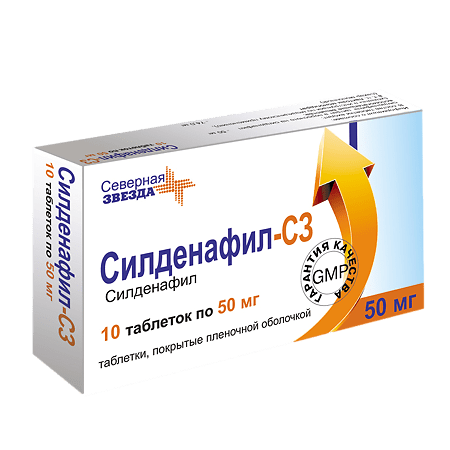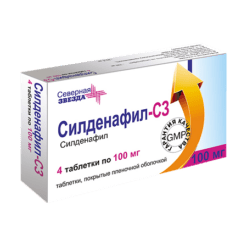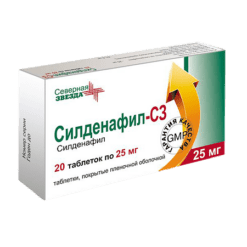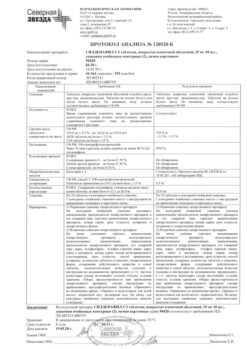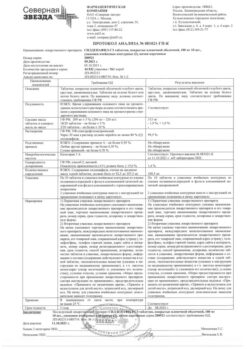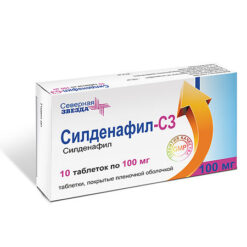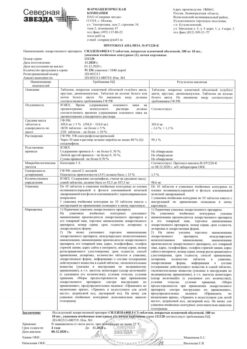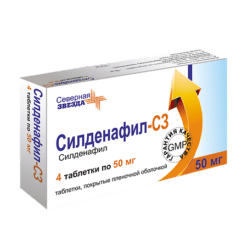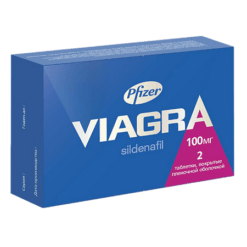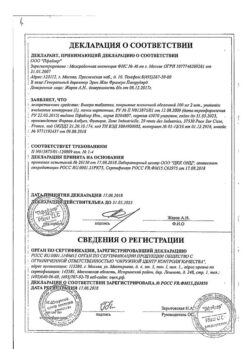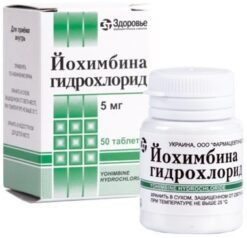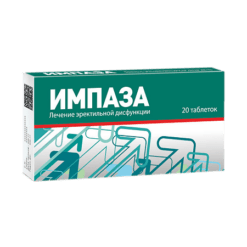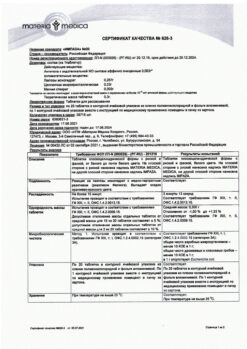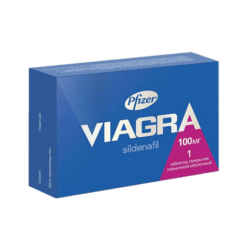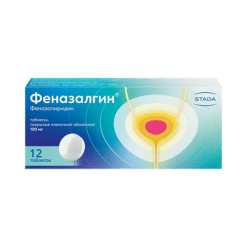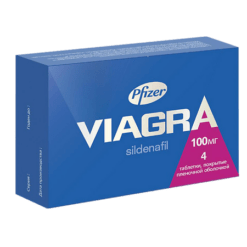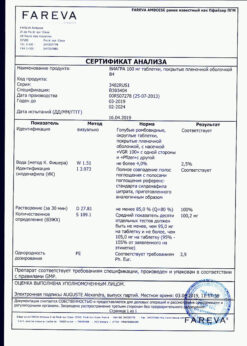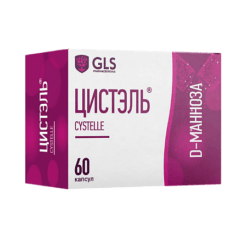No products in the cart.
Sildenafil-SZ, 50 mg 10 pcs
€9.83 €8.00
Description
Sildenafil is a potent selective inhibitor of cycloguanosine monophosphate (cGMP)-specific phosphodiesterase type 5 (PDE5).
Indications
Indications
The treatment of erectile dysfunction characterized by the inability to achieve or maintain an erection of the penis sufficient for satisfactory intercourse.
Sildenafil is effective only with sexual stimulation.
Active ingredient
Active ingredient
Composition
Composition
1 tablet sildenafil (in the form of citrate) 50 mg
Supplementary substances:
Microcrystalline cellulose – 54 mg,
Lactose monohydrate (milk sugar) – 74 mg,
croscarmellose sodium (primellose) – 10 mg,
povidone (polyvinylpyrrolidone medium molecular weight) – 10 mg,
magnesium stearate – 2 mg.
Shell contents:
Opadray II (polyvinyl alcohol, partially hydrolyzed – 2.4 mg, titanium dioxide (E171) – 1.374 mg, macrogol (polyethylene glycol 3350) – 1.212 mg, talc – 0.888 mg, aluminum varnish on the basis of diamond blue – 0.1152 mg, iron oxide (II) yellow (E172) – 0.0102 mg, iron oxide (II) black (E172) – 0.0006 mg).
How to take, the dosage
How to take, the dosage
Sildenafil is taken orally. The recommended dose for most adult patients is 50 mg approximately 1 hour before sexual activity. Depending on efficacy and tolerability, the dose may be increased to 100 mg or reduced to 25 mg.
The maximum recommended dose is 100 mg. The maximum recommended frequency of use is 1 time per day.
Kidney function abnormalities. No dose adjustment is required for mild to moderate renal impairment (creatinine Cl 30-80 ml/min), no dose adjustment is required for severe renal impairment (creatinine Cl
Hepatic impairment. Because sildenafil excretion is impaired in patients with liver damage (particularly in cirrhosis), the dose of sildenafil should be reduced to 25 mg.
Combined use with other drugs. If concomitantly used with ritonavir, maximum single dose of Sildenafil should not exceed 25 mg, and the frequency of use should be once every 48 hours (see “Interaction”).
When concomitantly using with cytochrome CYP3A4 inhibitors (erythromycin, saquinavir, ketoconazole, itraconazole), the initial dose of Sildenafil should be 25 mg. “
To minimize the risk of postural hypotension in patients taking α-adrenoblockers, Sildenafil should be started only after hemodynamic stabilization is achieved in these patients. It should also be considered to reduce the initial dose of sildenafil (see “Special Precautions” and “Interactions”).
Elderly patients. Adjustment of the dose of sildenafil is not necessary.
Interaction
Interaction
Influence of other drugs on the pharmacokinetics of sildenafil
The metabolism of sildenafil occurs mainly under the action of cytochrome CYP3A4 isoenzymes (main pathway) and CYP2C9, therefore inhibitors of these isoenzymes may decrease sildenafil clearance, and inducers, respectively, increase sildenafil clearance. There has been noted a decrease in sildenafil clearance when concomitant use of inhibitors of CYP3A4 cytochrome isoenzyme (ketoconazole, erythromycin, cimetidine). Cimetidine (800 mg), a non-specific inhibitor of cytochrome CYP3A4 isoenzyme, when taken together with sildenafil (50 mg) increases sildenafil concentration in plasma by 56 %. Concomitant use of sildenafil 100 mg together with erythromycin (500 mg/day, twice daily for 5 days), a specific inhibitor of cytochrome CYP3A4 isoenzyme, on the background of achieving a constant concentration of erythromycin in blood, leads to an increase in sildenafil AUC by 182 %.
When taking sildenafil (100 mg once) and saquinavir (1200 mg/day 3 times daily), an HIV protease inhibitor and CYP3A4 cytochrome isoenzyme, together, against achieving a steady concentration of saquinavir in the blood Cmax of sildenafil was increased by 140 % and AUC was increased by 210 %. Sildenafil has no effect on the pharmacokinetics of saquinavir.
The stronger CYP3A4 cytochrome isoenzyme inhibitors, such as ketoconazole and itraconazole, may also cause greater changes in the pharmacokinetics of sildenafil.
The simultaneous use of sildenafil (100 mg once) and ritonavir (500 mg twice daily), an HIV protease inhibitor and strong cytochrome P450 inhibitor, against reaching a steady blood concentration of ritonavir leads to an increase in Cmax of 300% (4 times) and AUC of 1000% (11 times). After 24 hours, plasma concentration of sildenafil is about 200 ng/ml (after a single use of sildenafil – 5 ng/ml), which is consistent with the information on the pronounced effect of ritonavir on the pharmacokinetics of various cytochrome P450 substrates. Sildenafil has no effect on the pharmacokinetics of ritonavir. Combined use of sildenafil with ritonavir is not recommended. If sildenafil is taken in recommended doses in patients receiving concomitant strong CYP3A4 cytochrome isoenzyme inhibitors, the Cmax of free sildenafil does not exceed 200 nM and the drug is well tolerated.
A single administration of an antacid (magnesium hydroxide/aluminum hydroxide) does not affect the bioavailability of sildenafil.
CYP2C9 cytochrome isoenzyme inhibitors (tolbutamide, warfarin), CYP2D6 cytochrome isoenzyme inhibitors (selective serotonin reuptake inhibitors, tricyclic antidepressants), thiazide and thiazide-like diuretics, ACE inhibitors and calcium antagonists, have no effect on sildenafil pharmacokinetics.
Asithromycin (500 mg/day for 3 days) has no effect on the AUC, Cmax Tmax, elimination rate constant and T1/2 of sildenafil or its major circulating metabolite.
The effect of sildenafil on other drugs
Sildenafil is a weak inhibitor of cytochrome P450 isoenzymes -1A2, 2C9, 2C19, 2D6, 2E1 and WA4 (IK50>150 μmol). When sildenafil is taken at the recommended doses, its Cmax is about 1 μmol, so it is unlikely that sildenafil can affect the clearance of substrates of these isoenzymes.
Sildenafil enhances the hypotensive effect of nitrates both with long-term use of the latter and when prescribed for acute indications. Therefore, the use of sildenafil in combination with nitrates or nitric oxide donors is contraindicated.
When the α-adrenoblocker doxazosin (4 mg and 8 mg) and sildenafil (25 mg, 50 mg, and 100 mg) were used concomitantly in patients with benign prostatic hyperplasia with stable hemodynamics, the mean additional decrease in systolic/diastolic BP in the supine position was 7/7 mm Hg, 9/5 mmHg and 8/4 mmHg, respectively, and in the standing position were 6/6 mmHg, 11/4 mmHg, and 4/5 mmHg, respectively. Rare cases of symptomatic postural hypotension, manifested as dizziness (without fainting), have been reported in these patients. In certain sensitive patients receiving α-adrenoblockers, concomitant use of sildenafil may result in symptomatic hypotension.
There are no signs of significant interaction with tolbutamide (250 mg) or warfarin (40 mg), which are metabolized by the cytochrome isoenzyme CYP2C9.
Sildenafil (100 mg) has no effect on the pharmacokinetics of HIV protease inhibitors, saquinavir and ritonavir, which are substrates of the cytochrome CYP3A4 isoenzyme, when their blood levels are constant. Sildenafil (50 mg) does not cause an additional increase in bleeding time with acetylsalicylic acid (150 mg). Sildenafil (50 mg) does not increase the hypotensive effect of alcohol in healthy volunteers at a maximum blood alcohol concentration of 0.08% (80 mg/dL) on average.
In patients with arterial hypertension, there is no evidence of interaction of sildenafil (100 mg) with amlodipine. The mean additional BP decrease in the supine position is 8 mmHg (systolic) and 7 mmHg (diastolic).
The use of sildenafil in combination with antihypertensive agents does not lead to additional side effects.
Special Instructions
Special Instructions
To diagnose erectile dysfunction, determine its possible causes, and choose an adequate treatment, a complete medical history and a thorough physical examination must be taken. Erectile dysfunction treatments should be used with caution in patients with anatomic penile deformities (angulation, cavernous fibrosis, Peyronie’s disease), or in patients with risk factors for priapism (sickle cell anemia, multiple myeloma, leukemia).
The drugs intended to treat erectile dysfunction should not be prescribed for men for whom sexual activity is undesirable.
Sexual activity poses some risk if you have heart disease, so your physician should refer you for a cardiovascular physical exam before starting any erectile dysfunction therapy. Sexual activity is undesirable in patients with heart failure, unstable angina, myocardial infarction or stroke within the last 6 months, life-threatening arrhythmias, arterial hypertension (BP > 170/100 mm Hg) or hypotension (BP < 90/50 mm Hg). Clinical studies have shown no difference in the incidence of myocardial infarction (1.1 per 100 people per year) or cardiovascular mortality (0.3 per 100 people per year) in patients treated with Sildenafil compared to patients treated with placebo.
Cardiovascular Complications
In the postmarketing use of sildenafil for the treatment of erectile dysfunction, adverse events such as serious cardiovascular complications (including myocardial infarction, unstable angina, sudden cardiac death, ventricular arrhythmias, hemorrhagic stroke, transient ischemic attack, hypertension, and hypotension) that were temporarily associated with sildenafil use. Most, but not all, of these patients had risk factors for cardiovascular complications. Many of these adverse events were observed shortly after sexual activity, and some were noted after sildenafil administration without subsequent sexual activity. A direct relationship between the reported adverse events and these or other factors cannot be established.
Hypotension
Sildenafil has a systemic vasodilatory effect resulting in a transient decrease in BP, which is not clinically significant and has no effect in most patients. Nevertheless, before prescribing Sildenafil, the physician should carefully assess the risk of possible adverse vasodilatory effects in patients with related conditions, especially during sexual activity. Increased susceptibility to vasodilators is seen in patients with left ventricular outflow tract obstruction (aortic stenosis, hypertrophic obstructive cardiomyopathy) as well as with rare multiple systemic atrophy syndrome manifested by severe autonomic nervous system BP dysregulation.
Because co-administration of sildenafil and α-adrenoblockers may result in symptomatic hypotension in some sensitive patients, Sildenafil should be used with caution in patients taking a-adrenoblockers. To minimize the risk of postural hypotension in patients taking a-adrenoblockers, Sildenafil should be started only after hemodynamic stabilization is achieved in these patients. It should also be considered whether it is reasonable to reduce the initial dose of Sildenafil. The physician should inform patients about what actions to take if symptoms of postural hypotension occur.
Visual impairment
Rare cases of anterior nonarteritic ischemic optic neuropathy have been reported as a cause of visual impairment or loss with all FDE5 inhibitors, including sildenafil. Most of these patients had risk factors such as optic disc excavation (deepening), age over 50 years, diabetes mellitus, arterial hypertension, coronary heart disease, hyperlipidemia, and smoking. No causal relationship between the intake of FDE5 inhibitors and the development of anterior nonarteritic ischemic optic neuropathy has been identified. The physician should inform the patient about the increased risk of anterior nonarteritic ischemic optic neuropathy if this condition has already been reported. In case of sudden loss of vision, patients should be treated immediately. A small number of patients with hereditary retinitis pigmentosa have genetically determined disorders of retinal phosphodiesterase functions. There is no information about the safety of sildenafil in patients with retinitis pigmentosa, so sildenafil should be used with caution.
Hearing impairment
Some postmarketing and clinical studies have reported cases of sudden hearing impairment or loss associated with use of all FDE5 inhibitors, including sildenafil. Most of these patients had risk factors for sudden deterioration or hearing loss. A causal relationship between the use of FDE5 inhibitors and sudden hearing impairment or hearing loss has not been established. If there is sudden hearing loss or hearing loss while taking sildenafil, consult a physician immediately.
Bleeding
Sildenafil enhances the antiplatelet effect of sodium nitroprusside, a nitric oxide donor, on human platelets in vitro. There are no data on safety of sildenafil use in patients with a tendency to bleeding or exacerbation of gastric and duodenal ulcer, therefore, sildenafil should be used with caution in these patients. The incidence of nasal bleeding in patients with LH associated with diffuse connective tissue disease was higher (sildenafil 12.9%, placebo 0%) than in patients with primary pulmonary hypertension (sildenafil 3.0%, placebo 2.4%). Patients who received sildenafil in combination with a vitamin K antagonist had a higher rate of nasal bleeding (8.8%) than patients who did not take a vitamin K antagonist (1.7%).
Performance with other treatments for erectile dysfunction.
The safety and effectiveness of Sildenafil with other erectile dysfunction drugs have not been studied, so this combination is not recommended.
Impact on driving and operating ability
There have been no adverse effects on the ability to drive or operate machinery while taking sildenafil.
However, since taking sildenafil may decrease BP, develop chromatopsia, blurred vision, and other side effects, careful consideration should be given to the individual effect of the drug in the above situations, especially at the beginning of treatment and when changing the dosing regimen.
Contraindications
Contraindications
With caution: anatomical malformation of the penis (angulation, cavernous fibrosis or Peyronie’s disease) (see “Special Indications”); diseases predisposing to priapism (sickle cell anemia, multiple myeloma, leukemia, thrombocythemia – see “Indications”). “Special Precautions”); diseases accompanied by bleeding; exacerbation of gastric and duodenal ulcer disease; hereditary retinitis pigmentosa (see “Special Precautions”). “Special indications”); heart failure, unstable angina pectoris, myocardial infarction, stroke or life-threatening arrhythmias in the last 6 months, arterial hypertension (BP >170/100 mm Hg) or hypotension (BP
Side effects
Side effects
Sildenafil side effects are usually mild to moderate and transient.
In fixed-dose studies, the frequency of
Bodies and organ systemsSide effectsSildenafil, %Placebo, %The most frequent side effects (> 1/10)Nervous systemHeadache164Cardiovascular systemVasodilation (“rushes” of blood to the skin of the face)101Frequent side effects (> 1/100 and < 1/10)Nervous systemDizziness21Visual disturbances (blurred vision, impaired color vision)2,50,4Chromatopsia (mild and transient, mainly altered perception of color shades)1,10,03Cardiovascular systemSpeedy heartbeat1,00,2Spiratory systemRinitis (nasal congestion)42Gastrointestinal systemDyspepsia72Diarrhea31Ureinary systemUreinary tract infections32Skin and subcutaneous tissueRash21/p>
When using Sildenafil at doses higher than recommended, adverse events were similar to those noted above, but tended to occur more frequently.
General disturbances: facial edema, photosensitivity reactions, shock, asthenia, pain, chills, abdominal pain, chest pain.
Allergic reactions: hypersensitivity reactions (including skin rash), Stevens-Johnson syndrome, toxic epidermal necrolysis (Lyell syndrome).
Central and peripheral nervous system disorders: somnolence, insomnia, hypoesthesia, paraesthesia, ataxia, neuralgia, neuropathy, tremor, depression, unusual dreams, decreased reflexes, stroke, transient ischemic attack, convulsions, including recurrent ones.
Cardiovascular system disorders: tachycardia, increased or decreased BP, myocardial infarction, atrial fibrillation, ventricular arrhythmia, unstable angina, AV-blockade, cerebral vascular thrombosis, heart failure, ECG disorders, cardiomyopathy, sudden death, syncope.
Respiratory disorders: nasal bleeding, asthma, shortness of breath, laryngitis, pharyngitis, sinusitis, bronchitis, increased sputum secretion, increased cough.
Gastrointestinal disorders: vomiting, nausea, dry oral mucosa, glossitis, colitis, dysphagia, gastritis, gastroenteritis, esophagitis, stomatitis, rectal bleeding, gingivitis.
Visual organ disorders: eye pain, eye redness/sclerae injection, conjunctival lesions, lacrimation disorders, anterior ischemic optical neuropathy, retinal vascular occlusion, visual field defects, mydriasis, cataracts, eye pain.
Hearing disorders: vertigo, tinnitus, tinnitus pain, deafness.
Blood and lymphatic system disorders: anemia, leukopenia.
Metabolism and nutrition disorders: thirst, gout, unstable diabetes, hyperglycemia, peripheral edema, hyperuricemia, hypoglycemic reaction, hypernatriemia.
Musculoskeletal system disorders: arthritis, arthrosis, myalgia, tendon rupture, tendovaginitis, bone pain, myasthenia, synovitis.
Skin and subcutaneous tissue disorders: urticaria, herpes simplex, itching, sweating, skin ulcers, contact dermatitis, exfoliative dermatitis.
Urogenital system disorders: cystitis, nycturia, frequent urination, gynecomastia, urinary incontinence, ejaculation disorders, genital edema, anorgasmia.
Reproductive system disorders: prolonged erection and/or priapism.
Overdose
Overdose
Single administration of Sildenafil in doses up to 800 mg resulted in adverse events comparable to, but more frequent than, those associated with lower doses.
The treatment is symptomatic. Hemodialysis does not accelerate clearance of sildenafil, because the latter is actively bound to plasma proteins and is not excreted by the kidneys.
Pregnancy use
Pregnancy use
The drug is not intended for use in women.
Similarities
Similarities
Additional information
| Weight | 0.011 kg |
|---|---|
| Shelf life | 3 years. |
| Conditions of storage | In a dry, light-protected place at a temperature not exceeding 25°C. Keep out of reach of children. |
| Manufacturer | North Star NAO, Russia |
| Medication form | pills |
| Brand | North Star NAO |
Other forms…
Related products
Buy Sildenafil-SZ, 50 mg 10 pcs with delivery to USA, UK, Europe and over 120 other countries.

